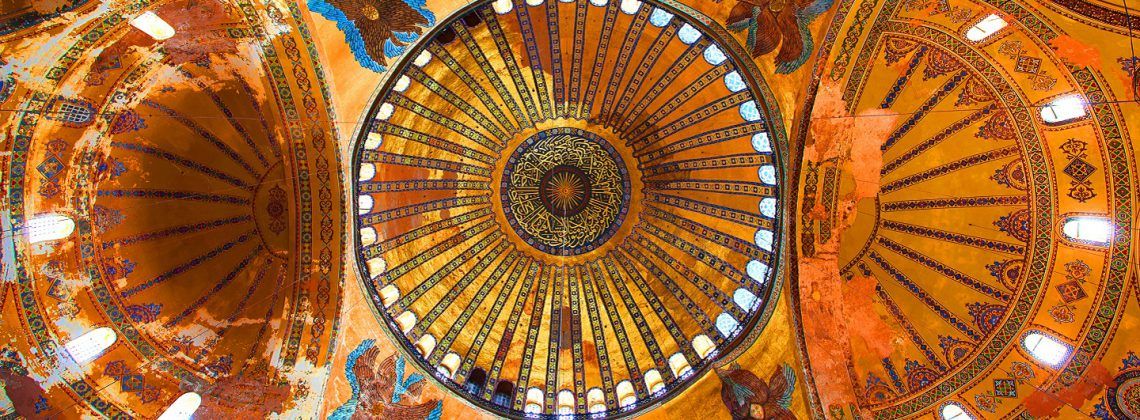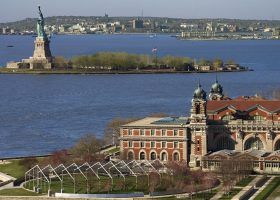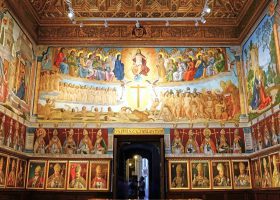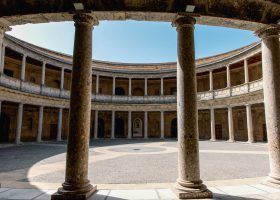The Hagia Sophia in Istanbul is one of the most famous buildings in the city. To be prepared for your visit, you’ll want to know a bit about its long history and discover what stunning architectural and artistic features to watch for! Here are the things to see at the Hagia Sophia.
Pro Tip: Planning a visit to Istanbul? Bookmark this post in your browser so you can easily find it. Also use our guide to Istanbul, local tips for things to do, and a great tour of Istanbul in a day.
What You Have to See at the Hagia Sophia in Istanbul
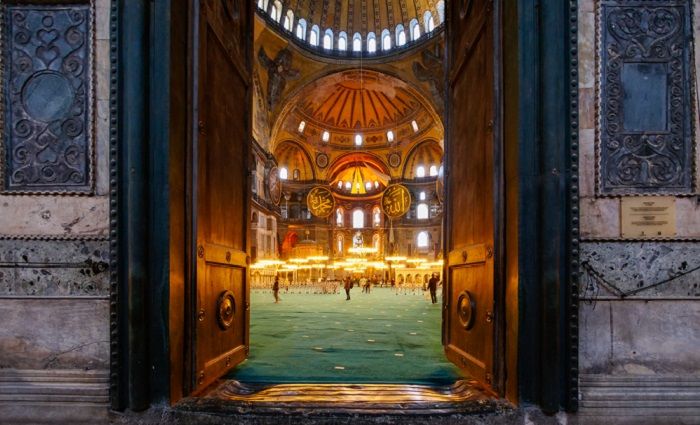
The Hagia Sophia (Ayasofya Camii in Turkish and Church of Holy Wisdom in English) is a UNESCO World Heritage site located in the old city of Istanbul. It’s the most-visited site by tourists, according to the Istanbul tourism site. You’ll find it at Sultanahmet Square across from the famous Blue Mosque.
The Hagia Sophia is a work of art that reflects early Byzantine artistic ideals, according to art historian Nadine Schibille. We know from contemporary historical texts that Emperor Justinian I of the Eastern Roman Empire (or the Byzantine Empire) commissioned the building as it’s known today and constructed it as a church between 532 and 537 A.D.
The Hagia Sophia has undergone many transformations since its foundation so there’s an array of architecture, designs, and art to see here. First, it was a Byzantine church. Then, after the Ottomans conquered the Byzantine capital of Constantinople (Istanbul) in 1453, the Ottomans converted the building into a mosque.
In 1931, Turkish President Ataturk remodeled the Hagia Sophia into a museum. Finally, in July 2020, the Turkish government reestablished the Hagia Sophia as a mosque.
Things to see at the Hagia Sophia include Norse inscriptions, Sultan’s tombs, and the many mosaics here. Not to mention, you might be surprised by how many Christian depictions you find in a mosque.
Things to Know
Since the Hagia Sophia is an active place of prayer and worship, there are a few things to keep in mind before visiting. First, there are suggested dress requirements: covered head and shoulders for women, below-the-knee clothing for men, and removed shoes before stepping on the prayer carpets.
Second, be sure to avoid visiting at prayer times when the mosque is closed to the public. Prayers occur in the early morning, midday, midafternoon, and evening.
Pro Tip: Be sure to check their website for all entry times!
11. Ancient Norse Graffiti
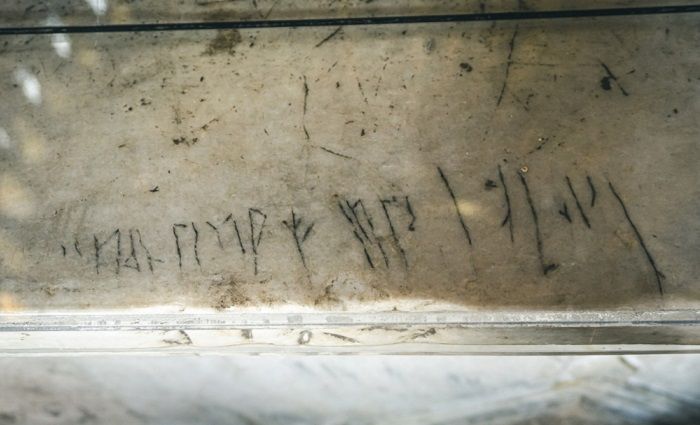
Writing | Runes | Viking Trade
The history of Istanbul as a city is long and complex. Located on the Bosporus and at the transition between the European and Asian continents, Istanbul is at a cultural and geographic crossroads. That means the Hagia Sophia is home to one fascinating example a cultural cross-section.
Scholars discovered two Norse runic inscriptions on marble walls of the Hagia Sophia! These date back to when the Byzantine Empire hired Viking mercenaries starting in the 9th century.
The pictured inscription is on the top floor of the southern gallery and it’s a little bit difficult to find. It is so small but such a treasure to find and worth seeing at the Hagia Sophia! Nordic linguist Elisabeth Svärdström and others translated the text as “Halfdan carved these runes.”
Even in antiquity, people had the urge to carve, “I was here!” However, please don’t do so today!
Not ready to book a tour? Check out our Istanbul Guide for more resources.
10. Four Towering Minarets
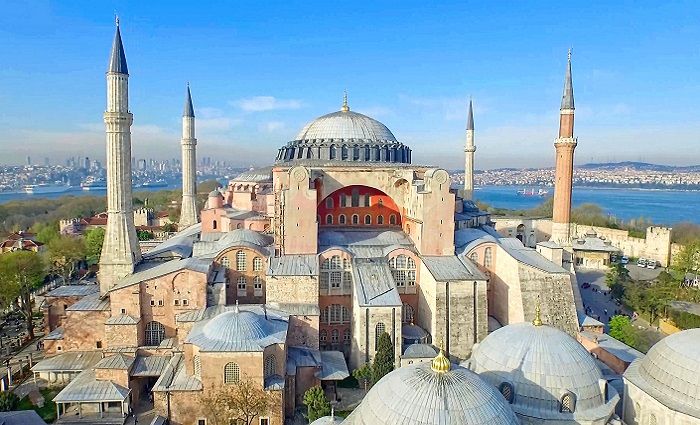
Minarets | Architecture | Mosque
The architecture of a mosque is distinctive—both inside and out. When you approach the Hagia Sophia for the first time, the minarets are one of the most obvious features you will see aside from the dome. The minarets are a later Ottoman addition and were added after the first conversion of the church to a mosque.
In total, there are four minarets at the Hagia Sophia. This is in contrast to most mosques, which have a single minaret from which the Muslim to call to prayer is projected. Notice how each of the minarets are of a different height? One is even made of brick! This is because the minarets were built at different times.
Various sultans commissioned the construction of each minaret at different times. We know this because each sultan wanted to make sure the world knew about their contribution to the Hagia Sophia, then, they documented it to make sure we’d know!
9. Geometric Icon: Omphalion
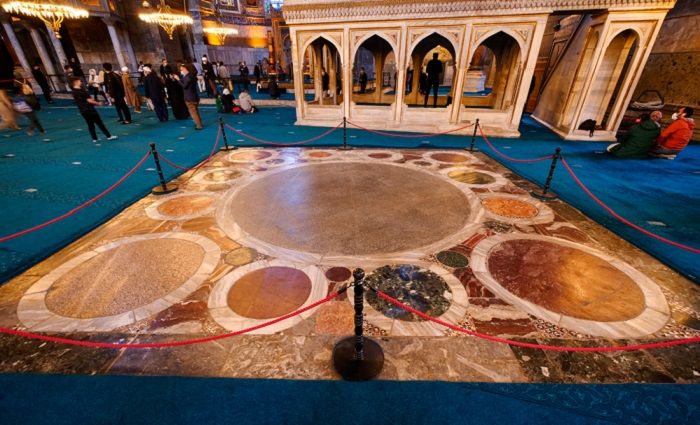
Marble | Geometry | Decoration
It might surprise you that today, much of the marble flooring in the Hagia Sophia is covered by carpet. This happened when the current Turkish government converted the building to a mosque.
However, one conspicuously uncovered part is the omphalion, an 18.5-foot-square decorative marble insert in the floor of the building. It consists of a total of 30 circles of various sizes. Notice the central circle surrounded by the others, which makes it multicolored and a fascinating feat of geometry.
Since historic documents dating back to the construction of the church do not mention this decoration (as Paul the Silentiary would have done), it is likely a later addition. So, that means the exact interpretation and meaning behind the unique flooring is lost to time.
However, according to the writings of 13th-century Russian archbishop Antony of Novogrod, the Byzantine emperors may have been coronated at this spot. Alas, we may never know, but you can certainly envision it as you stand here and admire it.
8. Historic Sultan’s Tombs
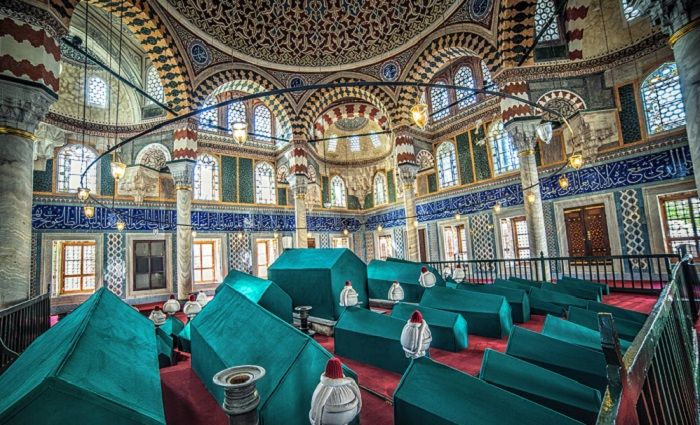
Tombs | Sultans | Ottoman
When you approach the exterior of the Hagia Sophia you will notice that there is more to the complex than just the main building. The Hagia Sophia itself is an ideal of Byzantine architecture. However, just around the corner, there is an exceptional example of Ottoman architecture.
Accessible through a separate entrance along the side are the tombs of five Ottoman Sultans and their families from the late 16th to the mid-17th centuries. You’ll find Sultan Selim II, Sultan Murad III, Sultan Mehmed III, Sultan Mustafa, and Sultan Ibrahim entombed here.
In contrast to the exemplary Byzantine architecture of the Hagia Sophia, the Ottoman sultans’ tombs are exceptional standards of Ottoman architecture. What exactly does that mean? Well, there is intricate tile work to see that the Ottomans are famous for. In addition, make sure to take in the gorgeous wood inlays.
Pro Tip: Each sultan’s tomb is a separate building and part of the Hagia Sophia Complex, but it is not part of the building itself and not well marked. To find it, go around the corner from the main entrance towards the rest of Sultanahmet Square.
Not ready to book a tour? Check out our Istanbul Guide for more resources.
7. The Monolithic Columns
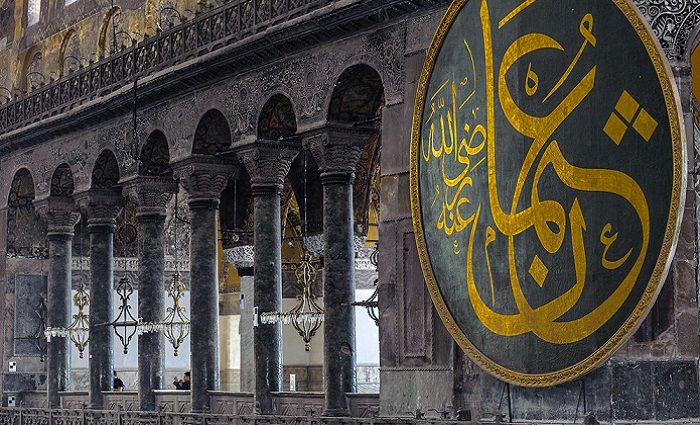
Legends | Marble | Temple of Artemis
To go along with the things to see at Hagia Sophia, you almost can’t miss these imposing columns, so you’ll love knowing the legends behind them. The history of the Hagia Sophia teems with myth and legends and each piece of architecture in the building tells a story, few of which are agreed upon. The 104 monolithic columns at the Hagia Sophia are no exception.
Architects and designers of the Hagia Sophia constructed the columns from different marbles in different styles. Although there are some famous columns, the set as a whole is fascinating to admire.
One tradition even holds that some of the columns come from the Temple of Artemis at Ephesus after warring conflicts destroyed it in the late 4th century A.D. However, Byzantine architectural historian Cyril Mango discredits this theory. What we can say, though, is that the marble for the columns comes from many different sources, including Larissa in Greece and the Eastern Desert of Egypt.
6. The Wishing Column
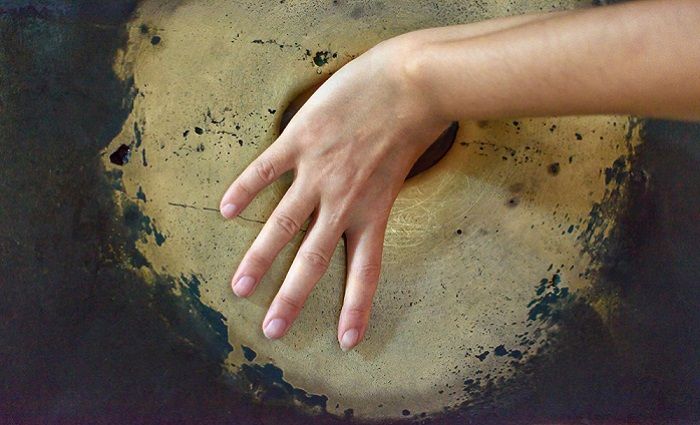
Legends | Marble | Virgin Mary
The most famous column at the Hagia Sophia is the Wishing Column—also called the Weeping Column. This column is located in the northwest part of the building and you won’t miss it. People gather in front of it throughout the day to make their wish!
The column is distinctive with a worn bronze plate surrounding a hole within the white marble column. The alternative name for the column, the Weeping Column, comes from the fact that the column looks like it is crying!
Of course there are superstitions here too. Some say the column represents the tears of the Virgin Mary or other important historical figures, but in reality, the wet column is likely due to the condensation that gathers on its surface.
The more famous name for the column, the Wishing Column, is because of its purpose. It’s said that if you put your thumb into the hole and fully rotate your hand while making a wish, your wish will come true!
Some legends hold that the column has healing properties based on far-fetched stories about Emperor Justinian and St. Gregory Thaumaturgus. The origins of these legends are varied, and although there are historical documents about them, there is no consensus. Either way, be sure to make your own wish here!
5. The Imposing Imperial Gate
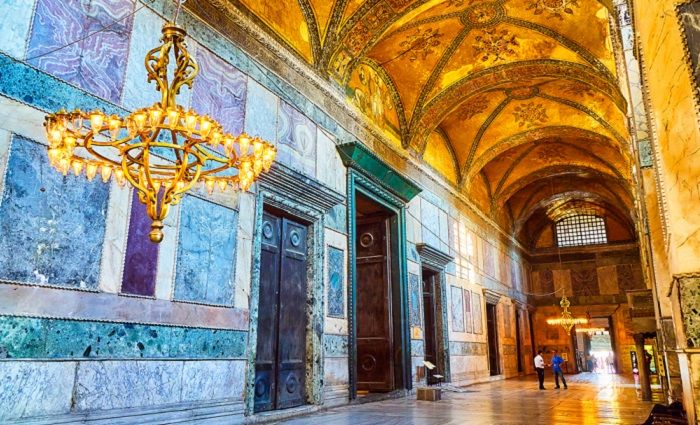
Gateway | Door | Noah’s Ark
After you have entered the building, there are multiple ways to access the inner sanctum. The most popular is located in the Narthex of the Hagia Sophia. A set of three doors made of oak stand tall here, hung on a bronze frame. The larger, central door is the Imperial Door. According to historical sources, only the Emperor and his entourage used the Imperial Gate to enter the Hagia Sophia.
At 7 meters tall it is the largest door in the Hagia Sophia, and what an imposing, statuesque portal it makes! Like so many features of the Hagia Sophia, there is a legend surrounding the door. In this case, it’s about the wood.
According to ancient Byzantine sources, the wood was derived from Noah’s ark. Yes, that ark. Sadly, there is no evidence that the legend is true and is most likely hyperbole. Still, it does make for an exciting story!
Not ready to book a tour? Check out our Istanbul Guide for more resources.
4. Mosaic of Jesus, Constantine, and Empress Zoe
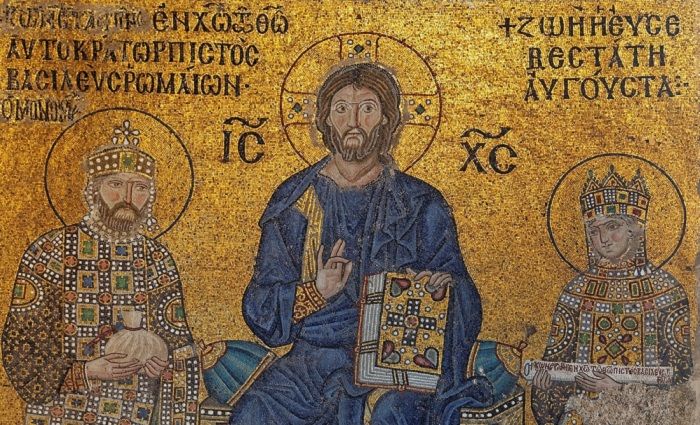
Mosaic | Eastern Wall | Repurposing
The mosaics at the Hagia Sophia are awe inspiring. Each one is amazing in its own right! However, a few are extraordinary for different reasons. One is the mosaic of Empress Zoe. Located on the southern gallery’s eastern wall, the mosaic shows Christ flanked by Constantine IX Monomachus and Byzantine Empress Zoe.
This mosaic is interesting for more reasons than just its example of Byzantine traditions. It is one of the few mosaics that has clear evidence for repurposing. Based on examinations by Byzantine Institute conservators, later artists reused early mosaics and replaced the faces and inscriptions, leaving the bodies of figures in the mosaic mostly untouched.
Fun fact: After the Ottomans converted the Hagia Sophia into a mosque in 1453, someone plastered over the mosaics and hid them. This is because of the Islamic tradition of aniconism, or the avoidance of artwork that portrays people. When the mosque was converted into a museum in 1931, the mosaics were completely uncovered for the first time since 1453!
3. Mosaic of Virgin Mary, Emperor Justinian, and Constantine
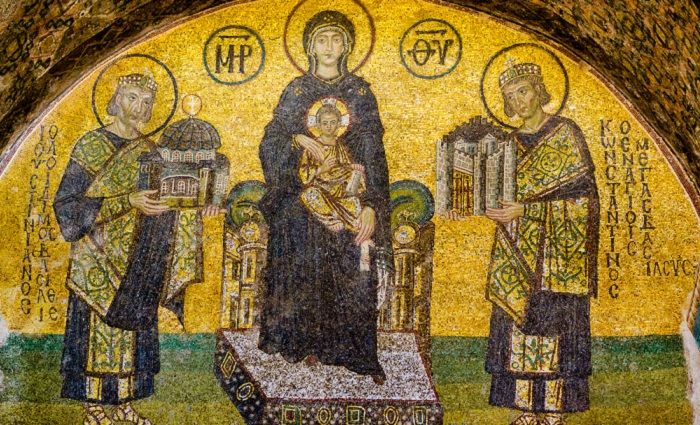
Emperors | Vestibule | Virgin Mary
Since the Hagia Sophia originally functioned as a church, you’ll see many Christian symbols throughout. One such repeated symbol is the Virgin Mary and the Christ Child. Possibly the best representation is this Byzantine mosaic dating back to the 10th century!
Located over the south door in the vestibule of the Hagia Sophia there is a mosaic with Mary and the child flanked by Emperor Justinian to the left and Emperor Constantine to the right.
If you look closely, you’ll see they’re gifting a representation of their significant accomplishments to Mary and Christ. Justinian is giving them a model of the Hagia Sophia, his greatest mark on the landscape of Istanbul. In contrast, Constantine offers them his city, Constantinople (modern Istanbul).
According to archaeologist Thomas Whittmore, who worked on the mosaic restorations in 1931, mosaicists put multiple layers of plaster on the walls before putting on the tesserae, which are the glass pieces you see in the mosaics.
2. Mosaic of the Virgin and Child in the Apse
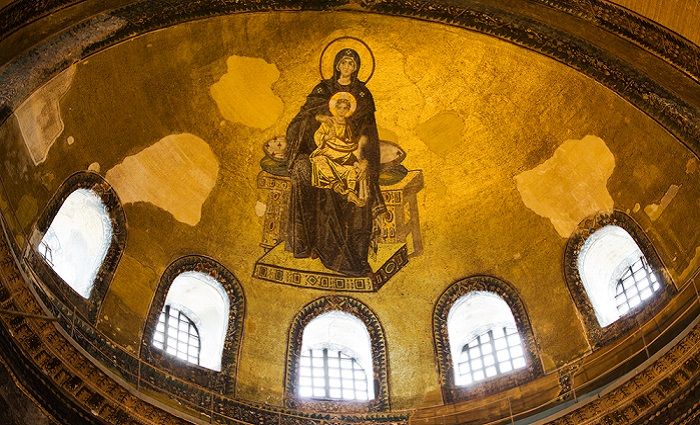
Mosaic | Apse | Virgin Mary
The apse of the Hagia Sophia is located at the eastern end of the building. Located in the center of the apse is one of the most famous mosaics of the Hagia Sophia.
Fairly well preserved, it depicts the Virgin Mary on a jeweled throne with the Christ Child in her lap. Look closely as you stand beneath this and you’ll see the archangels Gabriel and Michael are on panels around the central semi-dome.
Although this is one of the most recognizable mosaics of the Hagia Sophia, the exact date it was installed is not known. Art historian Natalia Teteriatnikov puts its installation to the sermon of Photius in 867.
1. The Dome
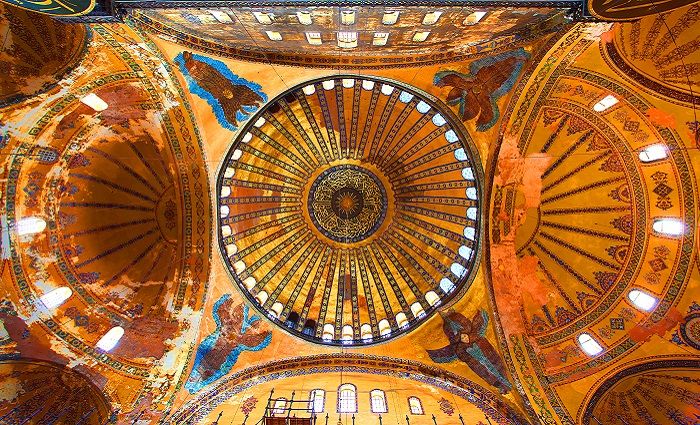
Domes | Vaults | Byzantine Architecture
From the outside, the dome of the Hagia Sophia draws your eye and is one of the first things you will see when you approach from any direction. In contrast to the Blue Mosque (visible from the entrance of the Hagia Sophia) there is only the one main dome here.
Once you enter the Hagia Sophia, you will be under the main dome. Based on measurements from the various restoration projects at the building, the dome today is about 175 feet (55 meters) above the floor. The dome is supported by an interesting architectural feature. Four pendentives (supporting arches) uphold the dome, and they represent the four sides of the rectilinear room.
What did dome look like when the Hagia Sophia was first constructed? Unfortunately, we don’t know. What you see today is a reconstruction—and worth every second you spend gazing up at the intricacy of it.
Architects considered to original to be structurally unsound. According to Procopius, the late Greek scholar of Roman history, it was Isidore the Younger who designed the renovated dome. He happened to be nephew of the primary architect for the Hagia Sophia, Isidore of Miletus. Keeping it in the family is an ancient tradition!
Not ready to book a tour? Check out our Istanbul Guide for more resources.
